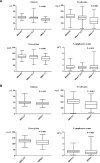Comparison of two malnutrition risk screening tools with nutritional biochemical parameters, BMI and length of stay in Chinese geriatric inpatients: a multicenter, cross-sectional study
- PMID: 30782871
- PMCID: PMC6411257
- DOI: 10.1136/bmjopen-2018-022993
Comparison of two malnutrition risk screening tools with nutritional biochemical parameters, BMI and length of stay in Chinese geriatric inpatients: a multicenter, cross-sectional study
Abstract
Objectives: The aims of this study were to assess malnutrition risk in Chinese geriatric inpatients using Nutritional Risk Screening 2002 (NRS2002) and Mini-Nutritional Assessment (MNA), and to identify the most appropriate nutritional screening tool for these patients.
Design: Cross-sectional study.
Setting: Eight medical centres in Hubei Province, China.
Participants: A total of 425 inpatients aged ≥70 years were consecutively recruited between December 2014 and May 2016.
Primary and secondary outcome measures: Nutritional risk was assessed using NRS2002, MNA, anthropometric measurements and biochemical parameters within 24 hours of admission. Comorbidities and length of hospitalisation were recorded. Nutritional parameters, body mass index (BMI) and length of hospital stay (LOS) were employed to compare MNA and NRS2002. Kappa analysis was used to evaluate the consistency of the two tools.
Results: The average age was 81.2±5.9 years (range, 70-98). The prevalence of undernutrition classified by NRS2002 and MNA was 40.9% and 58.6%, respectively. Patients undergoing malnutrition had lower BMI, haemoglobin, albumin and prealbumin (p<0.05), and longer LOS (p<0.05). The NRS2002 showed moderate agreement (κ=0.521, p<0.001) with MNA. Both tools presented significant correlation with age, BMI and laboratory parameters (p<0.001). In addition, a significant association between both tools and LOS was found (p<0.05). In addition, the NRS2002 was not different from MNA in predicting nutritional risk in terms of the area under the receiver operating characteristic curve (p>0.05).
Conclusions: The results show a relatively high prevalence of malnutrition risk in our sample cohort. We found that NRS2002 and MNA were both suitable in screening malnutrition risk among Chinese geriatric inpatients.
Keywords: Nrs2002; malnutrition risk; mna; older patients.
© Author(s) (or their employer(s)) 2019. Re-use permitted under CC BY-NC. No commercial re-use. See rights and permissions. Published by BMJ.
Conflict of interest statement
Competing interests: None declared.
Figures



References
-
- Guigoz Y. The Mini Nutritional Assessment (MNA) review of the literature–What does it tell us? J Nutr Health Aging 2006;10:466–85. Discussion 485-7. - PubMed
Publication types
MeSH terms
LinkOut - more resources
Full Text Sources
Medical
Research Materials
